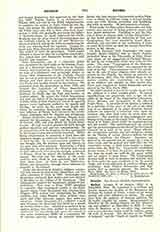

Rethel, ALFRED, b. at Aachen, 1816; d. at Düsseldorf, 1859. He combined in a brilliant and forcible manner the idealism of the Romantics and Italians, the realism of Durer, a sense of the monumental and strict adherence to nature. He might have been the greatest of German painters, but ill health crippled his energy. Recommended to Schadow by his teacher Bastme, his first oil-painting was exhibited at Dusseldorf in 1832; it represents St. Boniface, as do two other large canvasses and several sketches, which recall the realistic, powerful style of Lessing. The sketches of the “Battle of Sempach” and the “Death of Arnold von Winkeltied” betray the influence of Cornelius. The development of his sense of color and expressive dramatic spirit belong to his period of attachment to Veit (1836). The “Reconciliation of Emperor Otto I with his brother Henry” and “The Monk at the Coffin of Henry IV” are important works. In the “Nemesis pursuing a Murderer” is already crystallized the darker mood, which clouded the later life of the painter. For the Kaisersaal in Frankfort he painted four characteristic pictures of monarchs. With great admiration he studied the glowing coloring of Titian in strong contrast to the pale art of the Nazarene. After this many sided training follow his ripest works: “Hannibal’s March” powerfully depicts in six pictures the crossing of the Alps; in the “Frescoes from the Life of Charlemagne“, in the Rathaus at Aachen (see illustration in CHARLEMAGNE), the composition and coloring are both restrained and effective; his assistant Kehren completed the series with four greatly inferior pictures; the “Death Dance” depicts the horror of the Revolution of 1848. His superhuman strivings after the ideal were little appreciated by his townsmen and contemporaries. A softening of the brain afflicted him during his last years.
G. GIETMANN

